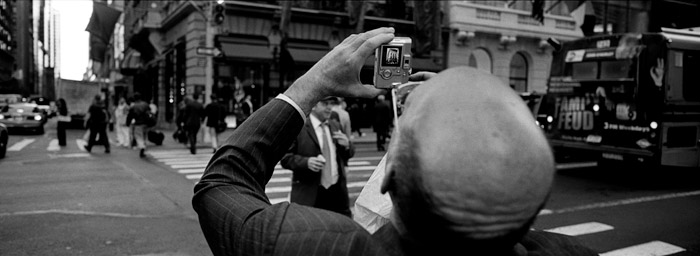September 11, 2007 What is a city?...
Lewis Mumford's definition of the city:
"The essential physical means of a city's existence are the fixed site, the durable shelter, the permanent facilities for assembly, interchange, and storage; the essential social means are the social division of labor, which serves not merely the economic life but the cultural process. The city in its complete sense, then, is a geographic plexus, an economic organization, an institutional process, a theater of social action, and an aesthetic symbol of collective unity. The city fosters art and is art; the city creates the theater and is the theater. It is in the city, the city as theater, that man's (sic) more purposive activities are focused, and work out, through conflicting and co-operating personalities, events, groups into more significant culminations."
(Mumford 1937: 185)
The public sphere of the city:
- City as a place of intersections, generating individual and social interactions. As a marketplace, as a place where symbolic capital accumulates. Congregation of craftsmen lead to technological innovations resulting from such productive encounters.
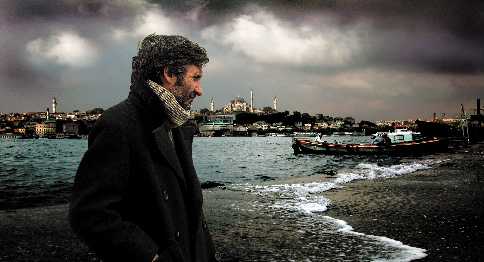
- Spatial proximities (urban intimacies), social distances (anonymity). Urban relationships very intimate, and very distant at the same time, usually serendipitous. Charles Baudelaire and Walter Benjamin's concept of the flaneur, a city-wanderer who experiences the city through walking without being recognized, with a freedom one would not find in rural settlements.
 | 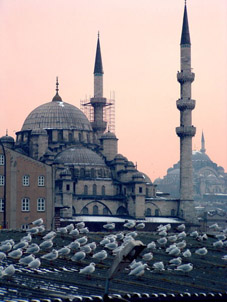 | 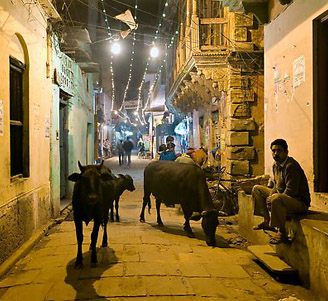 |
- Complex constellation of materialities: humans, animals, buildings, things, shaping the spatiality and temporality of urban space.
- Rhythms of the city: temporalities of urban space. Complexity of everyday routines, from one district to another it varies. 2 am in Istanbul's Taksim Square. Institutional mapping of time, festivals and commemorations. Daily, weekly rhythms, hybrid temporal sequences. Concept of timespace, place-events, event-places.
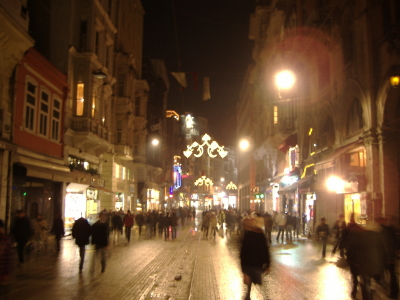
- Collectivities and collective imagination. As public spheres, city spaces serve as the ultimate grounds for reproduction of social relations, formation of collectivities and social identities, through urban rituals (religious and secular) and state spectacles. The opposite is also true: public spaces also stages of social conflicts, demonstrations, etc. Spatiality of the city is transformed by such social events and eventually impacts the nature of those social events. Baron Haussmann opened the Paris streets wide enough to avoid anti-state barricades set up by people.
- Institutionalization of collectivity. Urban bureaucracies. An economically structured world. Social division of labour, craft specialization.
- Complex hierarchization of spaces from the very private, intimate, domestic worlds to the public space of open engagements.
- Drama of everyday life (individual performances), and social events (festivals, state spectacles). Theaters of social actions, from micro-scale activities of the man on the street to the parade of the gods and rulers.
- The city with its architectural corpus is the theater in which urban life, urban drama unfolds. This urban drama continuously re-makes that architectural complexity, while creating a collectively shared understanding of the past, shared memories that become attached to particular architectural spaces. The city, with its monumentality and architectural poetics "intensifies and underlines the gestures of the actors and the action of the play" (Mumford)
- Complex layering of urban histories in material form and the citizens' imagination. Re-making and re-imagining of city-spaces. Kostof refers to urban form as a "receptacle of meaning" (Kostof 1991: 9).
- "The city, however, does not tell its past, but contains it like the lines of a hand, written in the corners of the streets, the gratings of the windows, the banisters of the steps, the antennae of the lightning rods, the poles of the flags, every segment marked in turn with scratches, indentations, scrolls" (Italo Calvino, Invisible Cities (1974) p. 11)
- Urban fabric: city as a unique "knowledge-space". Cities often act as places where specialized, technological knowledge is produced, exchanged, and put into use in productive material activities. These material processes greatly shape the urban environment through its special materials, craftsmanship, which is crystallized in the physical world of the city, its architectonic culture. The particular, the local configuration of technological knowledge become a unique urban fabric that knits the city's disparate spaces into one continuous narrative.
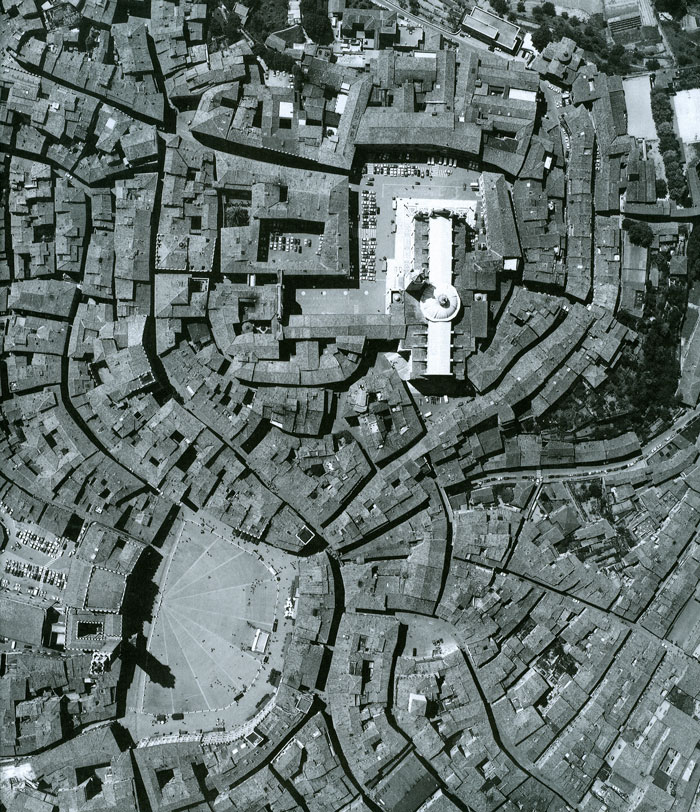 Siena (Italy). Image Source: S. Kostof, The City Shaped (1991) Fig.1.
Siena (Italy). Image Source: S. Kostof, The City Shaped (1991) Fig.1.
Major issues in reseraching cities:
- City and Landscape:
- Cities can only be understood through a critical geographical imagination that considers the multiplicity of regional and interregional networks that constitute and maintain the city. These are settlement systems, economic networks of production and exchange, roads and routes of long-distance travel, organization of landscape, tec.
- Density of Human Engagements:
- density in temporal, spatial as well as material means. An accelerated sense of time, a fast moving and fluid world, changing spatial structures with the beat of a heart, circulation of goods, commodities, objects in the urban center. Dense network of everyday performances
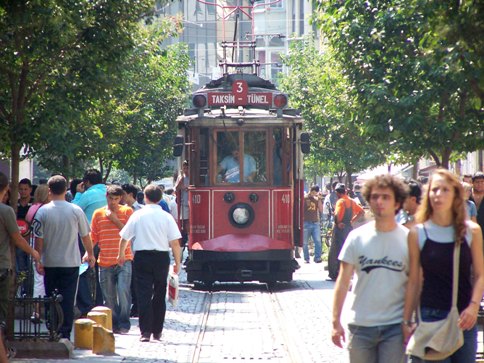
- Spatial Practices:
- that shape the city. Space-producing, space-altering practices that evolve with space, that constructs and deconstructs spaces, intentionally and unintentionally, discursively and nondiscursively. They are formed of both everyday habits and massive building projects.
- Mumford suggests that the city "as spatialized and spatializing entity of social connectedness".
- Spectacles and Everyday Performances:
- The city is a monumental stage for state spectacles and everyday performances. Oftentimes the two blend into each other, on a scale of intentionality/discursivity. We are not only dealing with the monumental structures of festivals and other large scale social events, we are also required to explore the residues, marks, traces of micro-scale human activities in space.
- Built form and social life:
- The relationship between the city's physical environment and its social life. Is it possible to separate the two? How do spatial practices, everyday performances, daily life, state spectacles shape the urban environment? Is it legitimate really to talk about physical space and social phenomena as if they were isolated from each other?
- We not only create and transform architectural spaces, but we also produce stories, myths, imaginations about them. These spatial imaginations CAN NOT be dissociated from the material corpus of the city. Not at all.
- Architectural body of the city emerges often as a symbol of collective identities.
- Ideal City:
- throughout history there has always been the tension between attempts for planning the urban environment (usually by the "state") and the micro-scale spatial activities that deconstruct and transform those planned structures. Planned city is a utopia. Human engagements with spaces always take over and gradually undo the rigid structuralism and sharp edges of its planners.
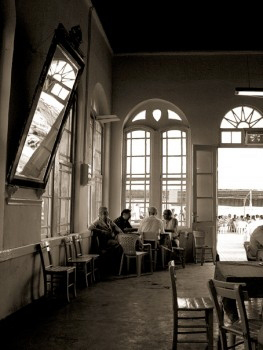 | 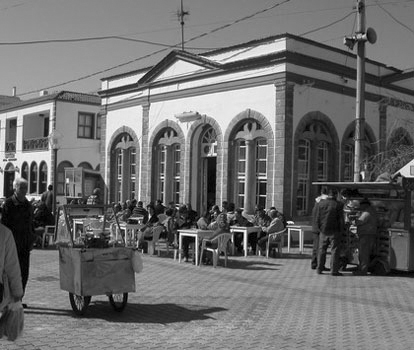 |
Coffehouse Taskahve, Ayvalik (Cunda Island), Turkey
